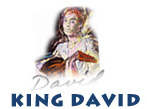

|
|
American-Israeli
artist Schwebel has produced a monumental series of paintings and etchings
on material in the books of Samuel and Kings. Examples of Schwebel's
paintings of David are accompanied by biblical texts translated by Prof.
Everett Fox. Fox, who holds the Glick Chair in Judaic and Biblical Studies
at Clark University, is the translator of The
Schocken Bible. The most recently published volume, Give
us a King! Samuel, Saul, and David (Schocken Books, 1999), incorporates
Schwebel's art.
Webcast
interview
with the artist Schwebel
About the artist
|
I was introduced to by the American-Israel artist Schwebel in the summer of
1996; he was at the time close to finishing his monumental series of paintings
and etchings on the material in Samuel and Kings, which was published in Israel
the following year under the title David. It is a unique body of work. Like
all great commentaries on the text, it moves back and forth between the past
and present; some pieces appear timeless in background and dress, while many
others are set in modern Jerusalem, particularly downtown, in the Judean hills,
and even in the Bronx of Schwebel's youth.
The work grew
out of the tangled and tragic events of Israel's Lebanon war, but war is not
its prominent theme. What makes Schwebel's David series so extraordinary, to
my mind, is its emotional power - a power that well matches the impact of text's
own. While it was not the artist's goal to connect with the purely religious
dimension of the narrative, he has engaged, in the tradition of Western classical
art, with the profound character studies found in Samuel. In his Sha'ul and
David, we may find, not "modernizing" portraits, but much of the richness of
biblical characters in all their pathos and complexity.
My live encounter with Schwebel's
paintings, which in the main are quite large and prominently feature the use of
color, had the effect of moving my work on The Early Protest immediately in the
direction of Samuel. I was literally compelled to shelve my work on Joshua and
Judges to concentrate on this one. For one who had previously received his impetus
solely from the aural aspect of the test, this visual development was an unusual
one, but it was occasioned by Schwebel's success in underscoring the book of Samuel's
intense and deep humanity, and by his engagement with its geographical setting.
I am grateful to him for his gift to the text and to me.
|
 From:
Everett Fox, Give Us A King! Samuel, Saul and David: A New Translation
of Samuel I and II. New York: Schocken, 1999. From:
Everett Fox, Give Us A King! Samuel, Saul and David: A New Translation
of Samuel I and II. New York: Schocken, 1999.
Schwebel, David, The King: From the Books of Samuel and Kings: Painting
and Etchings. Jerusalem: A Stabilized Chaos Production, 1998.
Paintings
reproduced permission of Schwebel.
|
KING
DAVID Table of Contents
|